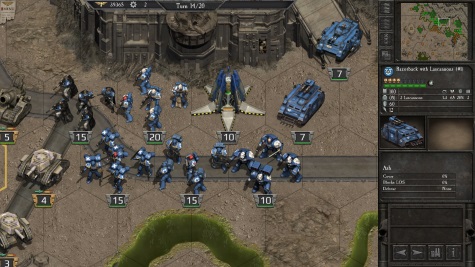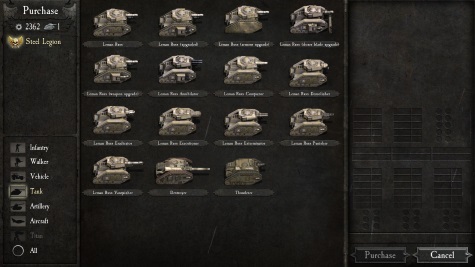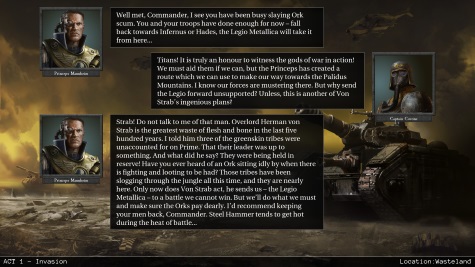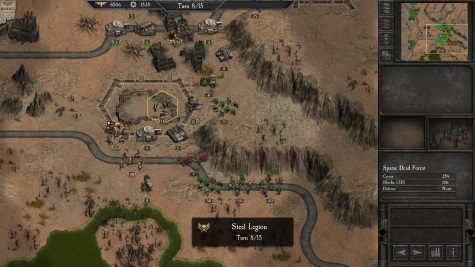For a very long time, Games Workshop refused to allow anyone to make video games based on their licensed properties. But now that they’ve jumped on the digital bandwagon the floodgates are totally open and there’s been all sorts of adaptations, some of them of dubious quality by rather small companies. This is one of the lower budget adaptations for their Battle for Armageddon boardgame by Slitherine, a company known for its hex-based wargames. I wouldn’t say this is low quality but it does have rather low production values, including spelling errors scattered around which are somehow still even after multiple patches.
It’s a bit silly to describe every hex-based wargame as a Panzer General clone but yes, if you’ve played that famous game you’d know what to expect here. (I never played it myself, but I did spend a fair amount of time on Fantasy General, which is I think only slightly less famous.) You control Imperial-aligned units of the Warhammer 40,000 universe and you fight against the Orks who are, once again, invading the presciently named planet of Armageddon. This includes everything from squads of infantry, wheeled vehicles, tanks, artillery pieces, aircraft up to the immense Titan units. As expected the action plays out on a hex map filled with forests, hills, trenches, rivers etc.
The game mechanics are fairly simple. There are no flanking attacks or bonuses for encirclement for example. The closest you get are support units which automatically fire on enemy units that are attacking an allied unit it is adjacent to, provided the enemy is in range. Units do have morale, which is depleted whenever they attack and especially when they receive damage. This apparently influences both attack and defense and is restored either through taking a turn to rest and refit or by being adjacent to an allied unit with the leadership ability. There’s no tech upgrade system. Better unit types are unlocked automatically over the course of the campaign. Each mission seems to have a fixed amount of requisition points available for you to purchase units or to replenish depleted ones.
The game makes up for it however with a bewildering array of unit types available. For example, there are well over a dozen variants of the Leman Russ tank used by the Imperial Guard. Some are straight up upgrades, better armor, more weapons and so forth and so cost more. But most are there so you can pick exactly the type of tank you think you’ll need for a given scenario. You might want to have more lascannons if you plan to kill enemy tanks or switch to heavy bolters if you’re facing hordes of infantry. The same goes for the famous Space Marine squads. Bolters? Flamers? Chainfists? Missile launchers? There’s a squad configuration for every occasion. The campaign allows access to three chapters of the armored giants: Salamanders, Blood Angels and Ultramarines, and there are small differences between the same unit types of the different chapters. Unless you’re extremely familiar with this property, you’ll likely have to spend a great deal of time learning all of the available unit types and comparing their stats.
Following a short tutorial act, the main campaign is divided into three acts. Roughly speaking these cover the initial Ork invasion, defensive actions as the Orks overwhelm more and more human cities and finally beating them back. There are plenty of scenarios in each act and it can take a surprising amount of time to complete a map so there are many, many hours of gameplay. I was pleasantly surprised by the variety of mission and map types in the first two acts. Open maps on plains call for a drastically different unit mix compared to tight maps in urbanized zones. Defensive scenarios are great opportunities to break out the heaviest enemies to sit on chokepoints and physically block the way of enemy units. But if you need to race against time across a large map, you might want to leave those slow superheavy tanks at home. Unfortunately I found the final act disappointing as they all consist of slogging through large maps against a large horde of enemies with little differentiation between the scenarios. The main difficulty with them is that the victory hexes are often laid out in such a way that you’ll need to separate your forces to proceed along more than one path simultaneously and it can be a bit tricky to work out how to break apart your forces into independently operating armies.
After a while I also got somewhat bored with always controlling Imperial forces against the Orks. Since the Orks are mostly quite good at melee but have really awful accuracy at range, your strategy is always going to burn them down from beyond their effective range and close for melee only for the killing blow. This means that for most of the game the artillery units of the Imperial Guard are your best friends. They only stop being effective towards the end of the game when there are many heavily armored Ork units that mostly ignore artillery. But using the same strategy over and over again gets old fast. I was really happy when one scenario had you fighting traitorous elements of the Imperial Guard but that turned out to be a one-time thing and it was a rather short and easy scenario to boot. It would have been fantastic if more of the factions from the property were represented but Slitherine only has the license for Armageddon, which means only the factions that were present at that battle.
The writing is awful and I am painfully reminded that the demographic that Warhammer primarily appeals to are young boys who think that huge men in power armor and wielding horribly oversized weapons are the height of coolness. I’m not even sure why they bothered including voice-acted dialogue involving the main characters in between missions, so cringe worthy are they. Still there were times when the missions got an emotional rise out of me. There’s one moment when you are tasked with defending a city to the last and your forces are slowly but inexorably being overwhelmed, and then, wham, the Space Marines arrive to save the day. That was both pulse-pounding and dramatically powerful.
Overall I had a fine time with this game. I have yet to try out the free Untold Battles DLC but I’ll probably at least try the Ork missions. I doubt that I’ll buy any of the other DLC however. I found this game to have a fairly manageable difficulty level but I read that some of the DLC scenarios are punishingly difficult. The main reason however is that I think I’ll only get so much mileage out of game mechanics that are so comparatively simple and doing more of the same just doesn’t appeal.



